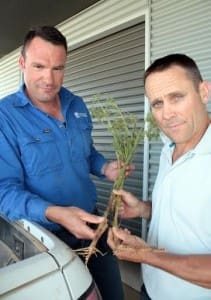
NSW DPI plant pathologist Kurt Lindbeck, left, and livestock development officer Geoff Casburn with a fungus-infected lupin plant.
A TOXIC fungus has been found on green lupins in the Riverina, prompting a warning to livestock producers.
NSW Department of Primary Industries (DPI) has alerted farmers to an unusual, early detection of a toxin-producing fungus, Diaporthe toxica, commonly called Phomopsis, which causes lupinosis.
No losses have been reported, but lupinosis can lead to production losses and deaths when livestock graze infected lupin stubble.
DPI plant pathologist, Kurt Lindbeck, detected the toxin-producing fungus on green lupin plants in the Riverina region of New South Wales.
“Lupin crops should be inspected now while plants are still green and if disease is detected lupin grain should be examined for discoloured seed, an indicator of the infection.
“Infected seed can also cause lupinosis and will spread the fungus if it’s sown,” Dr Lindbeck said.
“Moisture stressed plants are prone to early development of the fungus and the cold wet winter, followed by a dry spring has created ideal conditions for Diaporthe toxica.
“Most years we don’t expect to see Phomopsis until late in the season following summer rain after harvest,” he said.
DPI livestock development officer, Geoff Casburn, said lupinosis leads to liver damage and loss of appetite, poor production and sometimes death in sheep and cattle.
“Producers are advised to be cautious when grazing lupin stubble as it may be toxic earlier than expected and monitor stock daily for signs of the disease,” Mr Casburn said.
“The key to lowering the risk of lupinosis, if the infection level is unknown, is to reduce the need for livestock to graze lupin stems as they are likely to contain higher levels of toxin.”
“Choose paddocks with lupin grain and green weeds in lupin stubble – livestock naturally select seed and green material which provide higher quality feed and stock should be removed before that runs out.”
Riverina Local Land Services district veterinarian, Kristy Stone advised producers to monitor stock by moving them short distances to look for signs of weakness or listlessness, reduced appetite and jaundice – yellowing of the eyes and mouth.
“If producers suspect lupinosis, they should immediately remove the mob from the paddock or cease feeding lupin grain, then contact a local veterinarian for diagnosis and management options,” Ms Stone said.
A DPI Primefact available at DPI offices offers the latest lupin grazing management information, with photographs for identification of infected plants. It is also online at www.dpi.nsw.gov.au/__data/assets/pdf_file/0010/478243/Reducing-the-risk-of-lupinosis-and-the-incidence-of-phomopsis.pdf
Source: NSW DPI




HAVE YOUR SAY